In response to Russia’s full-scale invasion over the past year, Ukrainians have not only fought for their country but also to keep their culinary traditions alive
While Ukraine and its people have been forever changed by Russia’s full-scale invasion over the past year, one thing that has remained constant is Ukrainians’ drive to not only fight for their country but also for their culture and identity. One way they are preserving their heritage is through their cuisine.
As chef Ievgen Klopotenko from 100 Rokiv Tomu Vpered restaurant in Kyiv said, “I’m not on the front line, I’m on the food line. That’s why I have to fight here.”
Part of this fight is to make sure that Ukrainians – including those on the front line as well as refugees who have become displaced – are fed and nourished with a taste of home. Another part is to ensure that Ukraine’s culinary traditions live on within the country and beyond. And the reasons for doing this go back even further than the invasion on 24 February 2022.
During the Cold War, the Soviet regime standardised what countries in the Communist Bloc ate, creating a uniform “Soviet cuisine” and effectively diminishing the nations’ culinary distinctiveness – and in some cases, causing people to forget their own cuisine.
“Nearly all the restaurants in the USSR were replaced by identical government-run canteens (stolovyye) that served indistinguishable menus prepared from limited and often scarce produce, meats and other ingredients,” said author Anna Voloshyna, whose recent cookbook BUDMO! (meaning “let us be”, or the Ukrainian equivalent of “cheers”) highlights the joy and celebratory nature of Ukrainian home cooking. “The rise of the stolovyye was a dark time in the region’s culinary history, and many national cuisines are still recovering.”
For the newly independent nations following the USSR’s collapse, rediscovering their cuisines became an important part of reclaiming their identity. As Voloshyna writes, “With the end of Soviet rule in late 1991, many of the countries that have made up the so-called Eastern Bloc tried to disassociate themselves from their former alliance.” For Voloshyna and many Ukrainian women at the time, that meant turning to the ingredients that came from the garden or famers’ markets and cooking them at home.
Ukrainian cuisine is comfort food.
Often considered “the breadbasket of Europe”, Ukraine is known for its fertile land producing grains and cereals that are central to its cuisine. It’s also known for recipes – including borsch, holubtsi (cabbage rolls) and varenyky (dumplings) – that are based on garden vegetables, such as beets, cabbage and potatoes, and fruits. And while many of its dishes are similar to those of its bordering countries, like Poland, Slovakia and Hungary, they are also distinctly Ukrainian (although they might also vary from region to region, and even from family to family).
For Lena Sutherland, who grew up in the Ukrainian port city of Odesa and recently opened Lena’s Ukrainian Kitchen in the northern English city of Hull, her sour cherry varenyky are a reflection of Ukrainian access to fresh ingredients. Her mother would harvest sour cherries and use them for the dish, and she said that most people during her Ukrainian childhood had a garden that served as an outdoor pantry of sorts.
For cooks like Sutherland and Voloshyna, who are not currently living in Ukraine, sharing their dishes and recipes brings a sense of comfort to refugees who are missing home but also connects non-Ukrainians to their cuisine.
Cookbook author Olia Hercules, who lives in the UK but hails from Kahovka about 74km north of Crimea and recently published Home Food: Recipes to Comfort and Connect, said that encouraging others to cook Ukrainian food helps people relate to Ukrainians and helps to humanise them, despite the often-fatiguing negative news cycle of the war. For chef Yurii Kovryzhenko, who happened to be in London during the initial invasion last year and stayed to open Mriya Neo Bistro, “Ukrainian cuisine is comfort food.” His aim is to blend old-world traditions with modern innovation and creativity, taking dishes to a new level.
Whatever their specific approach might be, these five chefs (and no doubt many others) are collectively carrying the culinary torch for Ukraine at a most critical time and are spreading its light to others all over the world, ensuring that it will remain alive and continue to evolve. Here are five of their recipes offering a true – and unforgettable – taste of Ukraine: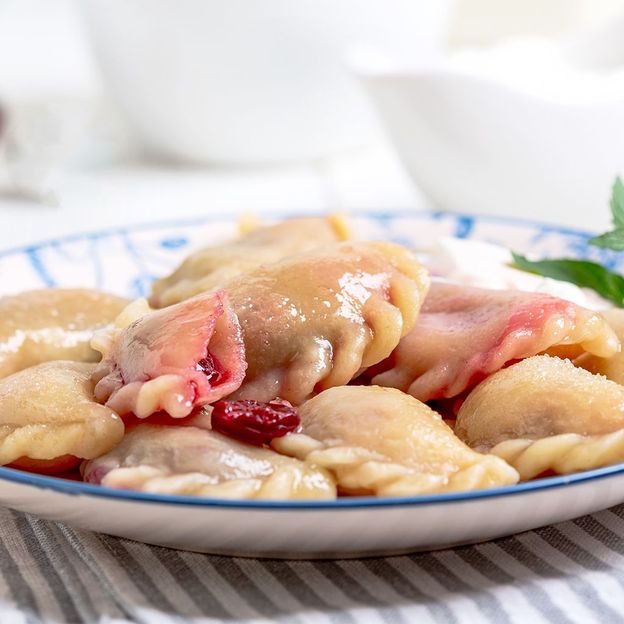
Sour cherry varenyky (Credit: SMarina/Getty Images)
Sour cherry varenyky (dumplings)
By Lena Sutherland
Stuffed with sour cherries sprinkled with a little sugar, they’re a sweet spin on Ukrainian dumplings that more commonly run savoury.
—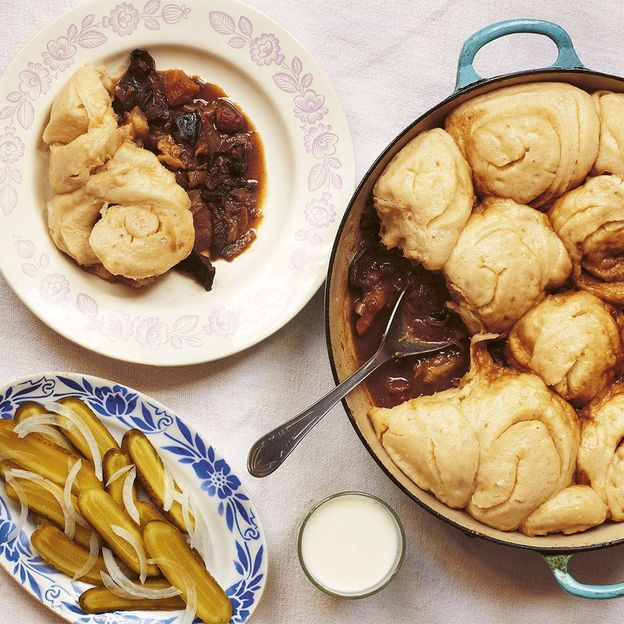
Olia Hercules’s nudli (Credit: Olia Hercules)
Nudli: Ukrainian dumpling stew
By Olia Hercules
Award-winning cookbook author Olia Hercules offers a vegetarian twist on this celebratory dish, with mushrooms and potatoes in a comforting but light vegetable broth.
—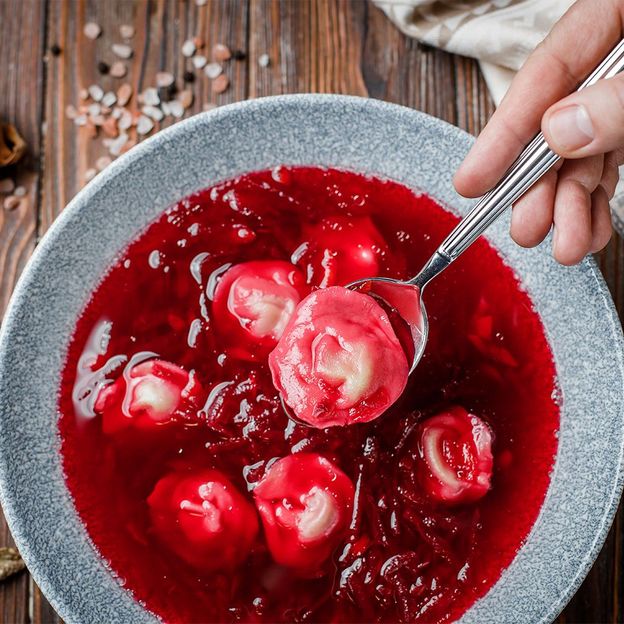
Ievgen Klopotenko’s vegetarian borsch with vushka (Credit: klopotenko.com)
Vegetarian borsch with vushka (dumplings)
By Ievgen Klopotenko
Meat features in many borsch recipes. However, Ukranian chef Ievgen Klopotenko makes a vegetarian version with potatoes, red beans and cabbage – and of course, beetroot as the star.
—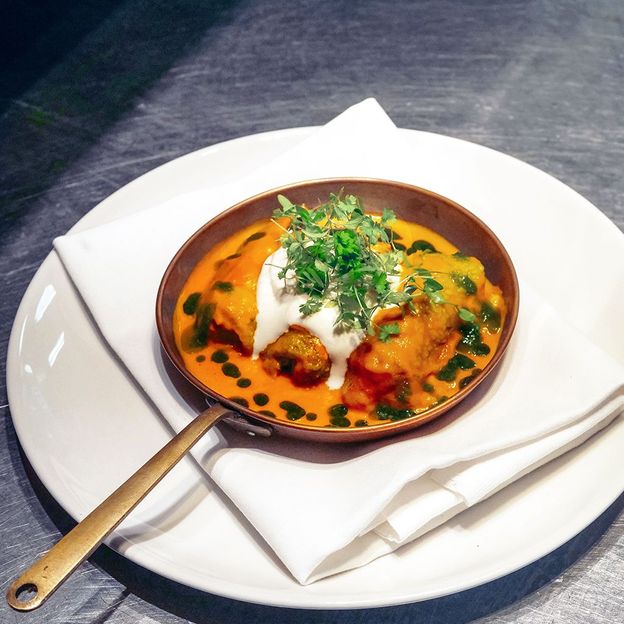
Yurii Kovryzhenko’s holubtsi (Credit: Alicia Erickson)
Holubtsi: Ukrainian cabbage rolls
By Yurii Khovryzhenko
Rolled cabbage leaves are stuffed with a mixture of potatoes and buckwheat, simmered in a rich tomato-red pepper sauce and topped with a dollop of sour cream.
—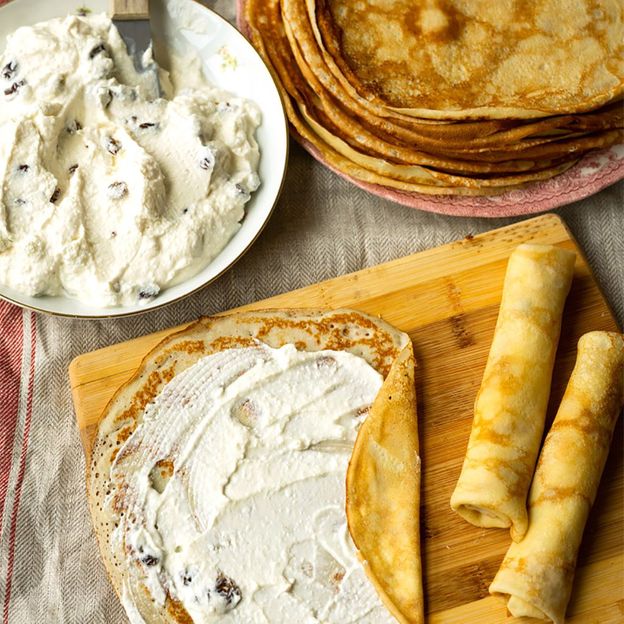
Anna Voloshyna’s nalysnyky (Credit: Anna Voloshyna)
Crepe-like with a crispy crust, nalysnyky is a quintessential dish made with syr or tvorog (farmer’s cheese), butter, milk and eggs – plus raisins and a touch of vanilla.
Source: BBC

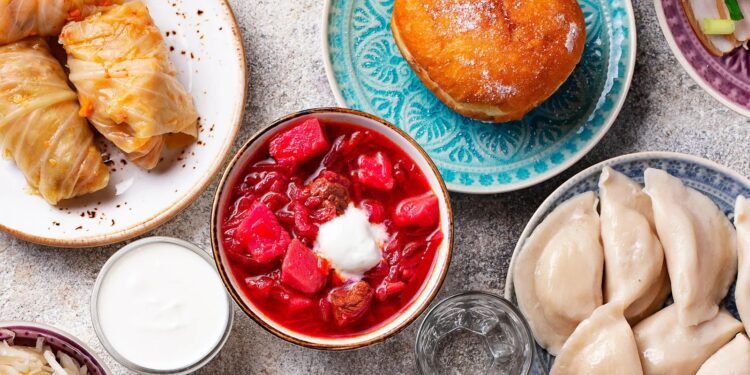
Recent Comments